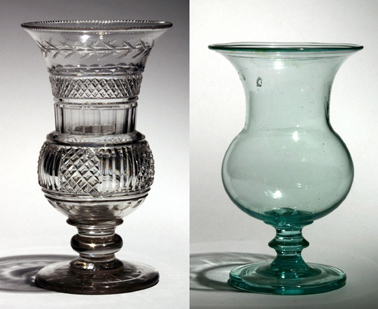Town and Country
Strikingly similar in form, two thistle-shaped vases with knopped stems and round, flat feet represent opposite extremes of 1830s’ decoration.

In the 1830s, cut glass was a highly prized luxury article. Cut decoration required a considerable amount of effort and expense. The extravagant, all-over decoration of this vase was a widely recognized sign of wealth and distinction.
By the 1930s, collectors favored country pieces. The country vase’s owner at the time, American Book Company president William Howe of Cincinnati, collected Early American Glass as an interesting contrast to his collection of rare American and English books. He even lectured on Early American Blown Glass.
Town-made cut glass remains a more difficult subject than country-made blown glass. Early scholars found much country blown glass near the factories that made it. Some descended in the families of glassworkers. Many factories could be excavated. In contrast, urban sites were invariably redeveloped. The site of one factory - Joseph Stouvenel and Company of Vesey Street, New York City - was later part of Ground Zero. Cut glass migrated with its highly mobile owners, often from city to city. As a result, attribution of cut glass relies on a combination of connoisseurship and occasional documented pieces. This particular vase relates to one associated with the Bloomingdale Glass Factory of New York City, sharing its form and many details of its cutting.

